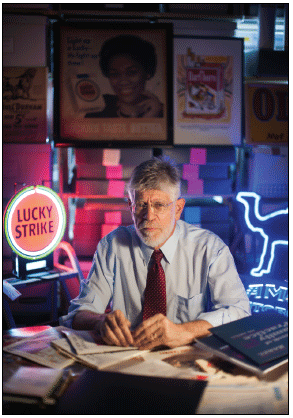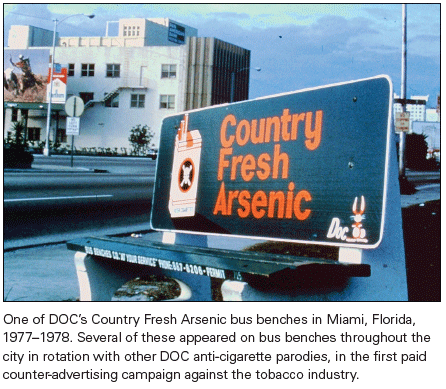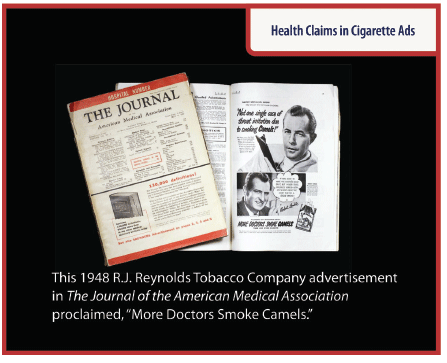Alan Blum on Why Physicians Need to Be More Active and Creative in the Clinic, Classroom, and Community in Smoking Prevention and Cessation
In this interview we discuss what needs to change in order to combat the negative health impact of tobacco use and what academic institutions and researchers can do to diminish the use of tobacco products.
Oncology (Williston Park). 31(1):17–20, 44.

Alan Blum, MD

One of DOC’s Country Fresh Arsenic bus benches

Health Claims in Cigarette Ads

Two-Faced Media

1.You are known worldwide as an expert on, and public advocate against, the use and promotion of tobacco products. How did you first become interested in this widespread health issue?
My father, a family doctor in Rockaway Beach, New York, was my inspiration. He recognized the devastating impact of smoking when he himself-a physician in his 40s who had smoked two packs of Chesterfield cigarettes a day since medical school-suffered a heart attack. Even though he was athletic and physically active, he knew that smoking had had a devastating impact on his life.
But consider that in the 1950s, two-thirds of doctors still smoked. Cigarette ads continued to be published in the Journal of the American Medical Association until 1954 (and tobacco companies continued to give out cartons of cigarettes at some state medical association meetings until the 1980s!).[1] One popular commercial of the early-1950s claimed that “more doctors smoke Camels than any other cigarette.” One day when my father and I were watching a Brooklyn Dodgers game on TV, sponsored by Lucky Strike, he urged me to tape-record the between-innings ads. That’s when I started tracking the tobacco industry like a parasitic disease. My father predicted that future generations would never believe that sports and smoking could have been promoted together. Yet this association continued in the US for another 50 years, by means of cigarette billboards in baseball and football stadiums and in sponsorships of televised sports such as Winston Cup Racing and the Marlboro Grand Prix.[2,3]
2.What do you feel is the most important historic milestone elevating public awareness of, or protection against, the harms of tobacco use?
In my opinion, the landmark medical publication of the 20th century in the US was the 1964 report on smoking and health by the Advisory Committee to the Surgeon General of the US Public Health Service. The major conclusion was blunt, sobering, and unequivocal: “cigarette smoking is causally related to lung cancer in men, far outweighing all other factors.” Moreover, noted Surgeon General Dr. Luther Terry at the press conference at which he released the report, smoking is “a health hazard of sufficient importance to warrant appropriate remedial action.”
But the American Medical Association (AMA) did not immediately join most of the world’s health organizations in endorsing the report, choosing instead to collaborate with the tobacco industry for the next 14 years on more research. The AMA would accept over $18 million from the tobacco companies for this effort, only to conclude in 1978 that the Surgeon General’s report had been right all along.[4] Not until the mid-1980s, by which time Surgeon General Dr. C. Everett Koop had gained popularity for using the office of Surgeon General as a bully pulpit to campaign against smoking, did the AMA jump on the bandwagon. I believe that the three theme issues on tobacco problems that I edited for the New York State Journal of Medicine and the Medical Journal of Australia-the first issues of any medical journal ever devoted entirely to a consideration of ending the world cigarette pandemic-also helped galvanize the involvement of the medical and public health communities into taking a more active role in standing up to the tobacco industry and its allies.[5-8]
3.In 1977, you founded Doctors Ought to Care (DOC), which you have described as the first medical organization dedicated to ending the tobacco pandemic. Can you share some of its public awareness activities?
DOC was the first dues-paying physicians’ group devoted entirely to health promotion.[9] As a resident in family medicine at the University of Miami, I began recruiting residents and medical students through the American Academy of Family Physicians. We started chapters in over 100 medical schools and family medicine residency programs. One hundred percent of our budget was devoted to countering the promotion of unhealthy products by means of paid advertising space in the mass media.
Joined by my colleague Dr. Rick Richards, we began buying ads on bus benches in Miami, Florida and Spartanburg, South Carolina with satirical slogans such as “Country Fresh Arsenic” (instead of Philip Morris’ “Marlboro Country”), “Arctic Lungs” (instead of the actual brand, Brown & Williamson’s “Arctic Lights”), and “Emphysema: The Disease That Takes a Decade to Make” (instead of Liggett & Myers’ “Decade: The Taste That Took 10 Years to Make”). We had to turn to bus benches because billboard companies would not sell us space once they realized we would be employing Mad magazine–style parodies to ridicule tobacco companies-their top customers. Our goal was to shift the focus away from smokers, nicotine addiction, and lung cancer and instead onto the pushers, their products, and their promotions.
We also created mock sports events at arenas and university campuses such as the Emphysema Slims Tennis Tournament and the Deadman Chew Softball League; sponsored the US Boomerang Team and a variety of professional motor racing vehicles; and led satirical protests (we called them “housecalls”) at dozens of tobacco-sponsored cultural and sports events throughout the US.
Our modus operandi was to use laughter and ridicule to get people to think differently about cigarettes and the tobacco industry. Thomas More famously said, “The devil can’t stand to be mocked.” In other words, the tobacco industry relished fending off claims that smoking was dangerous to health by giving money to universities and medical organizations to do more research aimed at identifying and removing any constituents of tobacco smoke that caused cancer. But the industry didn’t like to see ad campaigns by doctors that debunked cigarette filters, menthol brands, “light” and “ultra-light” cigarettes, and the very notion that smoking could be made safer. DOC spent thousands of dollars every year on such advertising in various media, including newspaper and magazine ads and TV and radio commercials, hoping to inspire the major health organizations, foundations, and government health agencies to do the same.[10,11] Although the federal government has long spent millions of dollars a year on paid advertising, such as to recruit teenagers into the military, it wasn’t until 2012 that any significant amount of federal funds was spent on anti-smoking ads in the mass media. That was the year the the Centers for Disease Control and Prevention launched its $48 million national campaign “Tips From Former Smokers™”, which the agency claims was both successful and cost-effective in reducing the prevalence of cigarette smoking.
I believe the most glaring failure of the public health and medical communities in the 20th century-and, for that matter, of the pharmaceutical, hospital, and insurance industries-was not putting their money where their mouth is to counteract the leading preventable cause of cancer.[12]
4. We have come a long way as a society in banning the use of tobacco products in public places and informing people about their dangers. What still needs to change in order to combat the negative health impact of tobacco use and some of these newer products, such as electronic cigarettes?
Even in 1977, there wasn’t a child over the age of 2 who hadn’t heard that smoking is dangerous to health. But lung cancer is abstract to children, adolescents, and millennials who believe they are impervious to bad health. In the clinical setting, most physicians are untrained in behavior modification, so counseling about smoking has been dumbed down to writing a prescription for a medication that patients demand after seeing the TV commercials. The pharmaceutical industry has thus taken over the field of smoking cessation, even though the best way to stop smoking remains “cold turkey.”[13-16]
I have been impressed by the work of Drs. Nicholas Christakis and James Fowler on social networking and lethal lifestyles.[17] They analyzed the Framingham Heart Study data and discovered that people who are obese hang out with other people who are obese, and people who quit smoking for good gravitate to other people who have also stopped smoking. The first question that I now ask patients who smoke is: “Who among your family and friends has stopped smoking and stayed stopped?” To me, social reinforcement is the sine qua non of smoking cessation, along with the creation of smoke-free environments. The passage by Congress in 1988 of the ban on smoking on commercial aircraft and the implementation and enforcement of clean indoor air policies in the workplace and public spaces over the past 40 years have done more to reduce the prevalence of smoking, in my opinion, than any other factor.
The good news is that cigarette smoking has been cut by more half over the last 50 years to under 20%, but the bad news is that 36.5 million Americans, most in the 18- to 34-year-old age group, still smoke, and the rate of decline in smoking is slowing down.
What more needs to be done to regain momentum on this issue? We must look more closely at what medical schools, health insurers, foundations, government agencies, and voluntary health associations are doing-or not doing. Medical schools as a rule have neglected to address smoking in their curricula, doubtless in part because it is too intellectually simplistic. I don’t think they have given confidence to medical students, residents, or physicians that they can do anything about this issue other than wag their finger, prescribe a medication, and say, “Go home and stop smoking.”
Medical organizations and universities can also start by cleaning up their own house. Tobacco stocks are still among the most profitable in the world, and retirement funds, including TIAA-CREF, the largest pension fund for teachers, are often major shareholders of tobacco stock.[18] I think it’s absurd for universities, medical schools, hospitals, health insurers, or physicians to profit from the sale of cigarettes-and yet many still do. Divesting tobacco stocks and saying no to such ill-gotten gains should be a minimum standard for institutions and individuals who claim to be fighting smoking. The same goes for retail pharmacy chains (and supermarket chains with pharmacies) that still sell cigarettes while dispensing medications for cancer and other smoking-caused diseases.
I don’t think that we have had any kind of leadership in anti-smoking efforts in the governmental arena since Dr. Koop. In 2009 the US Food and Drug Administration (FDA) was granted the power to regulate tobacco products, but Congress rendered the agency almost powerless to do anything about conventional cigarettes.[19] So the FDA devotes its efforts to creating new and improved warning labels for cigarette packs (which I believe is like yelling louder at a person who is deaf) and demonizing electronic cigarettes, which aren’t even a tobacco product, and which have not been found to cause death or disease, and have in fact shown promise in smoking cessation.
It’s a shame that the American Cancer Society (ACS) seems to have left it to a Washington lobbying group, the Campaign for Tobacco Free Kids (CTFK), to lead the national effort against smoking. CTFK is the same organization that joined forces with Philip Morris to write the Congressional bill that gave the FDA regulatory oversight of tobacco products, The Family Smoking Prevention and Tobacco Control Act.[20,21] If the ACS, which takes in over $1 billion a year to fight cancer, were to devote the portion of its budget that is proportional to smoking-attributable cancer deaths, it would be spending over $300 million a year to decrease demand for cigarettes. Yet the ACS spends a tiny fraction of that amount to prevent smoking and reduce the burden of tobacco-caused diseases. Its one-day-a-year Great American Smoke-Out simply doesn’t hack it any more.
5. In addition to purchasing and taking advantage of mass media to drive down tobacco use, what additional work could be done by academic institutions and researchers to continue to diminish the use of tobacco products?
Unfortunately, when it comes to research about smoking, we are learning more and more about less and less. We have now had proof for over half a century that cigarette smoking causes lung cancer, heart disease, and emphysema. We know what we should have done, yet we continue to spend money on more research rather than paying to educate the public more creatively to act on what we have long known about cigarettes. Even a single major campaign to explode the myth that filtered, low-tar, or light cigarettes are safer could do more to undermine consumer demand for these products than all the conventional disease-mongering efforts to date. The wackiest project of all just might be the FDA’s Centers of Excellence in Tobacco Regulatory Science, under which 13 universities and the American Heart Association are each receiving nearly $20 million apiece over 5 years, not to take actions to curb smoking, but rather to keep studying the problem in order to build evidence for more regulations.[22] Thus, we have come full circle back to the cigarette manufacturers’ Council for Tobacco Research, founded in 1954, which touted and funded more research as the solution to any problems that might be caused by smoking.[23] We need to expose and confront health organizations, universities, and companies that still collaborate with cigarette manufacturers.[24] Siemens, the world’s foremost health technology corporation and maker of equipment for hospitals and clinical laboratories, is still designing cigarette manufacturing technology and aiding Philip Morris and British American Tobacco in the processing of tobacco products. Meanwhile, the cancer research fundraising telethon Stand Up To Cancer is partnering with several corporate and foundation sponsors that benefit from the manufacture, promotion, or sale of cigarettes, including Siemens, Time Inc, Conde Nast, and the Safeway Foundation.[25,26] When we hear leaders of cancer centers soliciting funds for a moonshot to find a “cure” for cancer without emphasizing that we can already prevent upwards of 40% of cancers by not smoking cigarettes, we should cringe in embarrassment.
Financial Disclosure:The author has no significant financial interest in or other relationship with the manufacturer of any product or provider of any service mentioned in this article.
The views and opinions expressed in this piece are those of the author and do not necessarily reflect those of ONCOLOGY.
References:
1. Blum A. When ‘More doctors smoked Camels’: cigarette advertising in the journal. NY State J Med. 1983;83:1347-53.
2. Blum A. Tobacco in sport: an endless addiction? Tobacco Control. 2005;14:1-2.
3. Blum A. The Marlboro Grand Prix: circumventing of the television ad ban on tobacco advertising. N Engl J Med. 1991;324:913-6.
4. Blum A, Wolinsky H. AMA rewrites tobacco history. Lancet. 1995;346:261.
5. The world cigarette pandemic, part I. New York State J Med. 1983;83:1242-71.
6. The world cigarette pandemic, part II. New York State J Med. 1985;85:279-477.
7. Aspects of the cigarette pandemic. Med J Australia. 1983;i:193-248.
8. Anonymous. World cigarette pandemic (editorial). Lancet. 1985.2:989.
9. Blum A. Medicine vs. Madison Avenue: fighting smoke with smoke. JAMA. 1980;243:739-40.
10. Blum A. Paid counter-advertising: proven strategy to combat tobacco use and promotion. Am J Prev Med. 1994;10:8-10.
11. Blum A. Role of the health professional in ending the cigarette pandemic: clinic, classroom, and community. J Nat Cancer Inst Monogr. 1992;37-43.
12. Blum A. Tobacco and Cancer. In: DeVita et al, editors. Cancer: principles and practice of oncology. Philadelphia: JB Lippincott, 1993:480-91.
13. Blum A. Nicotine chewing gum and the medicalization of smoking. Ann Intern Med. 1984;101:121-3.
14. Lindson-Hawley N, Banting M, West R, et al. Gradual vs abrupt smoking cessation: a randomized, controlled noninferiority trial. Ann Intern Med. 2016;164:585-92.
15. McQueen N, Partington EJ, Harrington KF, et al. Smoking cessation and electronic cigarette use among head and neck cancer patients. Otolaryngol Head Neck Surg. 2016;154:73-9.
16. Yang I, Hall L. Smoking cessation and relapse challenges reported by postpartum women. J Matern Child Nurs. 2014;39:375-80.
17. Christakis NA, Fowler JH. The collective dynamics of smoking in a large social network. N Engl J Med. 2008;358:2249-58.
18. Blum A. Ethical investors failed to spread the word. Financial Times. October 25, 2013, p 8.
19. Siegel MB, Blum A. FDA regulation of tobacco: reprieve for the Marlboro man? Lancet. 2006;368:266-8.
20. Wilson D. Philip Morris’s support casts shadow over a bill to limit tobacco. New York Times. March 31, 2009. http://www.nytimes.com/2009/04/01/business/01tobacco.html. Accessed December 28, 2016.
21. Barker KG. Thank you for regulating: why Philip Morris’ embrace of FDA regulation helps the company but harms the agency. Admin Law Rev. 2009;61:197-224.
22. National Institutes of Health: Office of Disease Prevention. Centers Research Portfolio. https://prevention.nih.gov/tobacco-regulatory-science-program/research-portfolio/centers. Accessed on December 19, 2016.
23. Blum A. Ethics of tobacco funded research in US medical schools. Tobacco Control. 1992;1:244-5
24. Blum A. Alchemy, the safer cigarette, and Philip Morris. Lancet. 2008;371:1644-6.
25. Blum A. Big tobacco has surprising friends. Tuscaloosa News. March 27, 2015, p 6A.
26. Ong MBHO. Tobacco interests contribute a portion of the $109 million raised by SU2C. Cancer Letter. Sep 12, 2014. http://cancerletter.com/articles/20140912_2/. Accessed December 19, 2016.